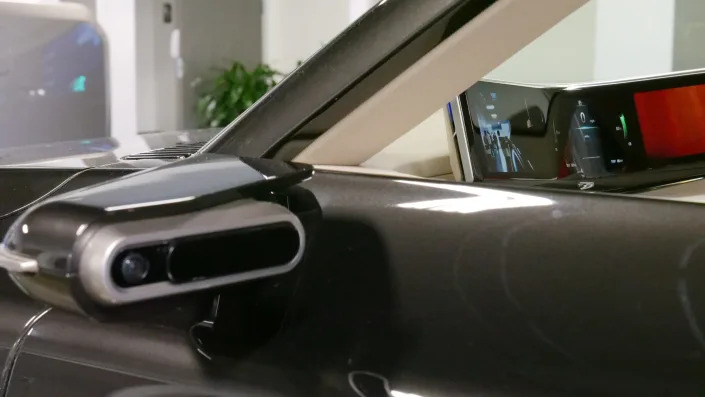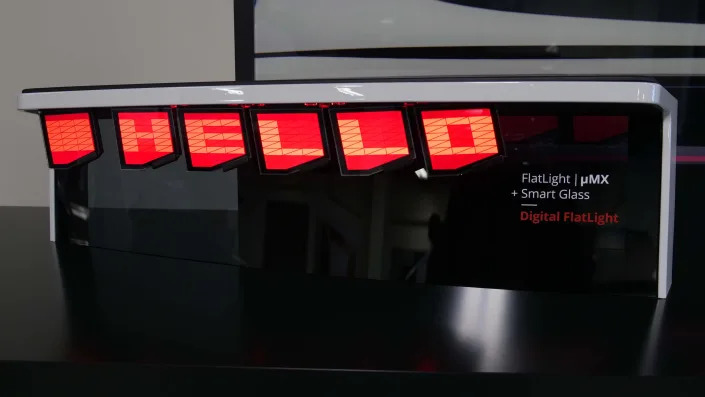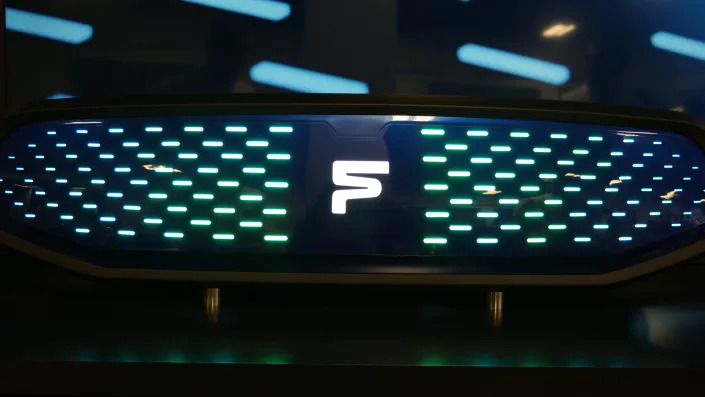Mark Phelan, Detroit Free Press
Sat, February 18, 2023
Electronic sideview mirrors and adaptive headlights that avoid oncoming drivers’ eyes and communicate with pedestrians are among features drivers can expect soon, according to European parts supplier Forvia.
Some of the systems are already available in other parts of the world, but U.S. regulations slowed their adoption here.

Video cameras will replace side mirrors on some vehicles. The image can be seen on screens inside the car.
Forvia, which specializes in interior systems, lighting and electronics, also is developing a variety of eco-friendly materials that use hemp and other sustainable sources to reduce automakers’ carbon footprint.
I recently got a look at those and other new features at Forvia’s North American tech center in Auburn Hills.

Forvia lights can display symbols or letters.
High-def sideview video
The eMirror goes into production this year in China. It uses video cameras to replace or augment outside sideview mirrors.

Video cameras will replace side mirrors on some vehicles.
The first vehicles likely to get the feature in the U.S. will likely be pickups and SUVs that have outsize mirrors for towing big trailers, said Valerie Zelko, manager for the electronic mirrors and other driver assistance features.
The cameras can provide wide fields of view, eliminating blind spots without the distortion caused by optical wide-angle mirrors. They can also incorporate other sensors, lighting up to alert of vehicles oncoming on either side.
The cameras will allow automakers to replace the current big mirrors — major sources of aerodynamic drag that reduce fuel economy and increase wind noise — with smaller mirrors that can be used if the camera fails. U.S. safety regulations require that backup, but European and Chinese vehicles will be able to dispense with outside mirrors altogether.

Forvia LED lights can be used for illumination, decoration, or to communicate with pedestrians and other vehicles.
Interior radar protects children and pets
Millimeter-wave radar detectors will make sure drivers can’t walk off and forget a pet or infant in a hot, locked vehicle — even if they’re sleeping. The radars will even recognize the minute chest movements of a child sleeping under a blanket, and they’ll scan every inch of the interior, from front footwells to the cargo compartment.
The radars can also be linked to smartphone apps for alerts.

LED lights creating a logo and decorative lights on a vehicle's grille panel.
More:Hybrids, EVs dominate Consumer Reports top vehicle picks; US shut out of top 10 brands
More:I saved nearly $37 vs. gasoline on my EV road trip. Most EV owners do better.
Smart headlights, really smart
LED technology is about to add a host of features to exterior lights.
Automakers will be able to display their logo as a lighted, 3D hologram. The grilles of driverless delivery vehicles could display colored, moving arrows to let pedestrians know that the vehicle is aware of them, and they can safely cross the street.

Forvia LED lights can be used for illumination, decoration, or to communicate with pedestrians and other vehicles.
Other features coming soon will include active headlights that view the road ahead and selectively disable individual LEDs so as not to shine in other drivers’ eyes. The headlights will also be able to project lights on the road to follow the lane, or directions from the nav system.
Electric vehicles that no longer need open grilles for engine cooling provide a rich canvas for advanced LED lights, including special effects to welcome the driver.
Seats that are good for the planet and your back
Forvia’s developing a host of new materials with lower carbon footprints than vehicles use today. The company says 60% of the carbon emissions from producing a vehicle come from the production of materials. New materials that use hemp and other sustainable or recycled sources are key to Forvia’s goal of carbon neutrality by 2040. Other new materials in the works include lightweight polyester, 100% recyclable material to replace the foams used in seat cushions. In addition to a lower environmental impact, Forvia says the material is more comfortable because it’s full of air pockets that keep the driver cool on long drives.

Forvia is developing materials for car interiors using hemp, and fiber from pineapple leaves.
Other materials in the works include fibers from pineapple leaves, already in use by the fashion industry.
Forvia developed what it calls a “fully sustainable” seat that incorporates plastics that incorporate hemp with the recyclable polyester and a steel frame.
This article originally appeared on Detroit Free Press: Forvia's high tech upgrades coming soon to US vehicles
No comments:
Post a Comment